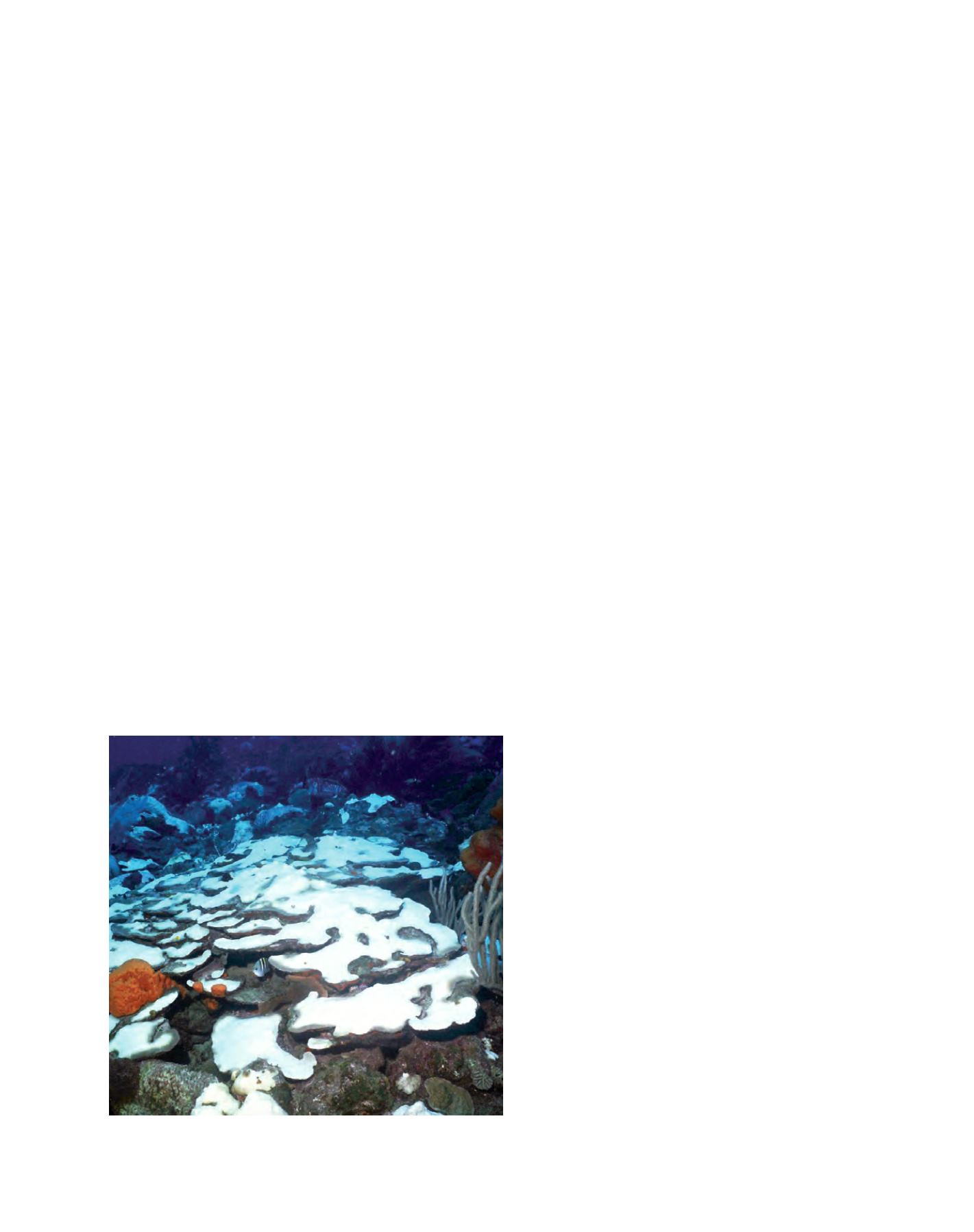

[
] 43
T
he
I
mpacts
and
I
mplications
of
C
limate
C
hange
and
V
ariability
The ‘catch up’ reefs are those which were initially found
in deeper water, but caught up after sea-level rise slowed
down. On this type of reef are found younger, shallowwater
corals growing on top of older deep water corals. The ‘give
up’ reefs are those that have stopped accreting, usually the
deeper water corals.
Barbados, unlike many of its neighbours is a relatively
flat island and therefore extremely susceptible to inundation
from sea-level rise. Most of our critical infrastructure, such
as the major hospital, and central police headquarters, lies
within a kilometre of the coast, and will be lost if IPCC’s
prediction comes true, without major preventative works.
The island is already experiencing serious levels of coastal
erosion and has undertakenmajor coastal restorative works
to protect beaches. On the optimistic side, Barbados appears
to be undergoing tectonic uplift, and seems to be keeping
pace with sea-level rise. However, if this situation does not
last, our ‘keep up’ and ‘catch up’ reefs might be experiencing
difficulties in the future.
Increased intensity of storms and hurricanes
The IPCC predicts that hurricanes and other extreme
weather events will become more severe. Intense wave
action generated by such events has already resulted in
physical damage to the reef structure as well as sediment
smothering, due to runoff resulting from increased rain-
fall. Moderate storms were thought to have a beneficial
effect on reefs by removing the old, sick and otherwise
compromised corals, thus clearing the way for new corals
to settle. However, present day coral reefs are already
impacted by such a plethora of negative factors, that
knocking them down at this stage has only resulted in
dead corals being overgrown by algae which further limits
coral recruitment. Recovery times (from storm damage)
have been estimated at around 50 years for Caribbean
reefs, however this period will most likely have to be
extended due to the prevalence of other impacts such as
bleaching, disease and over growth by algae.
10
Coral reefs have already experienced sea level changes,
ice ages and other extreme climatic conditions. It is as yet
unclear, if the climate induced stresses being exerted on
present day coral reefs are merely a part of the global boom
or bust cycle as described by Hubbard
11
or if they are expe-
riencing unprecedented new stresses, which together could
result in the annihilation of our coral reef ecosystems. That
question remains unanswered as we continue to tackle the
issue of reducing atmospheric carbon dioxide as well as
other anthropogenic impacts such as nutrient and sediment
loading, physical damage and overfishing on coral reefs.
What is clear, however is that coral reefs as we know
them will cease to exist, along with their accompanying
ecosystem services, unless serious measures are taken now
to reduce levels of carbon dioxide. According toWilkinson
and Souter
12
, warming from past greenhouse gas emissions
has already committed us to more bleaching events by the
2030s. However, if the greenhouse gases are dramatically
reduced within the next 20 years, and with careful manage-
ment of the coral reef resources that exist presently, we
might be able to preserve some of this important ecosystem.
The bleaching phenomenon is an extremely serious matter for all
tropical islands like Barbados especially since it doesn’t seem that
there will be a reversal of the global warming trend, even under the
most optimistic future climate scenarios.
7
Ocean acidification
The uptake of anthropogenic carbon since 1750 has led to the ocean
becoming more acidic, with an average decrease in pH of 0.1 units.
8
By the end of the century, acidification might be occurring at a rate
one hundred times faster, and three times greater than has occurred
on our planet during the last 21 million years.
9
This is expected to
lead to a reduction in the rates of calcification of reef-building corals
by between 14-30 per cent by 2050. If corals are unable to build,
rates of bioerosion will exceed that of growth and their infrastruc-
ture could essentially crumble.
Sea-level rise
According to the IPCC, sea level rose around 6-7 inches during the
twentieth century, which was ten times faster that the rate during the
last 3,000 years. They have additionally predicted a 7-23 inch rise in
the global average sea level by the 2090s, however many scientists
are concerned that the rate will actually be higher, since some recent
studies have been showing that the ice sheets of parts of Antarctica
and Greenland are melting much faster than previously anticipated.
Coral reefs are expected to respond to sea-level rise in a number of
ways, based on their ability to accrete calcium carbonate and the pace
of the rise. If reef structure is compromised as a result, then secondary
impacts such as beach erosion are likely to follow. Coral reefs are in
constant motion, continually accreting and pushing themselves upwards,
as well as being bioeroded. According to Neumann andMacintyre corals
will respond to sea-level rise in three ways. Theywill either keep up, catch
up or give up. If the rates of accretion can keep pace with the rise in sea
level, the reefs will keep up. These are primarily shallow water corals,
which maintain their presence in shallow water as the sea-level rises.
Bleached colony of
Montastrea faveolata
on Maycocks Reef during the 2005 event
Image: CERMES, University of the West Indies
















